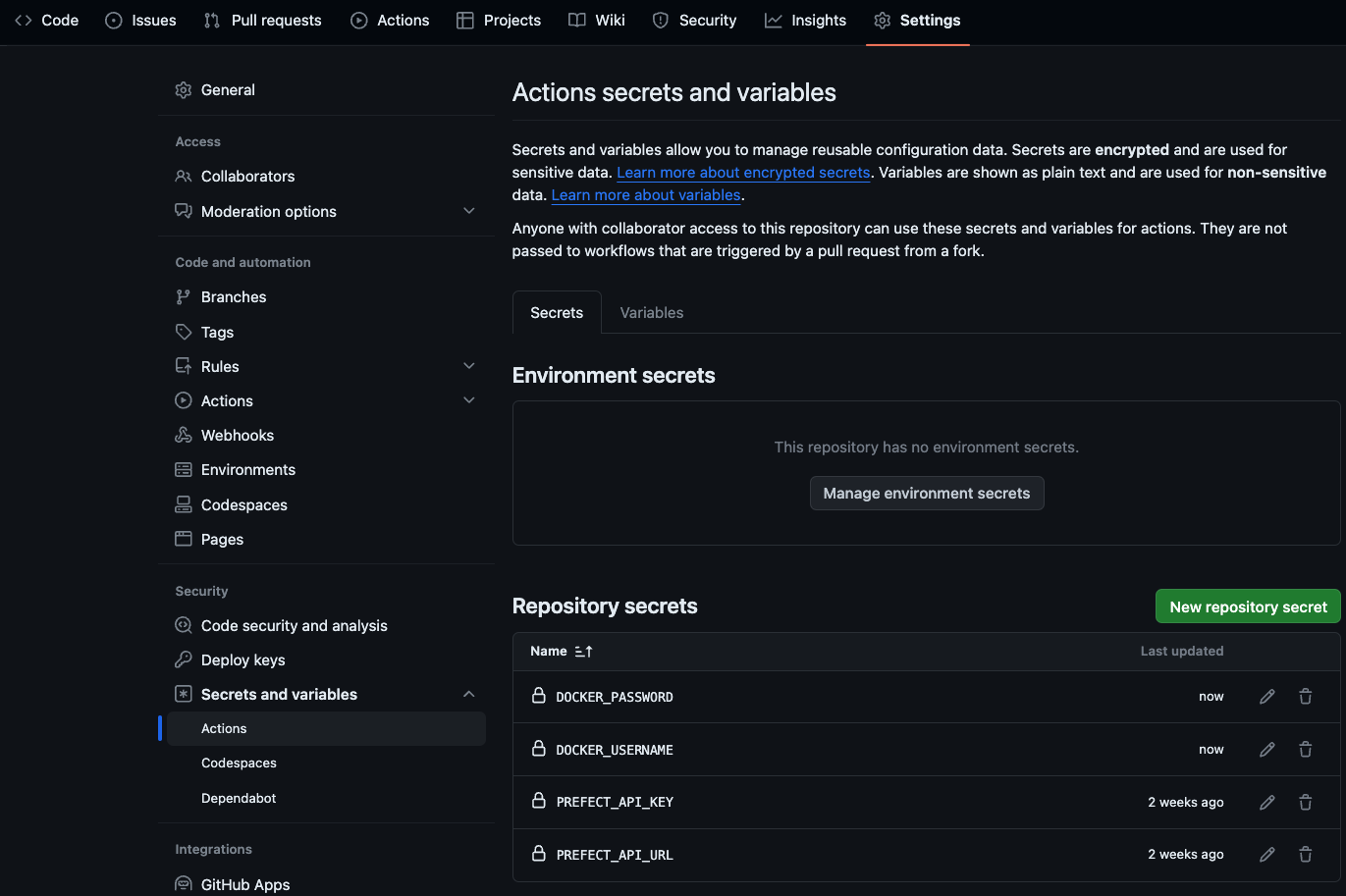.deploy flow method or a prefect.yaml
configuration file, are both designed for building and pushing images to a Docker registry.
Get started with GitHub Actions and Prefect
In this example, you’ll write a GitHub Actions workflow that runs each time you push to your repository’smain branch. This workflow builds and pushes a Docker image containing your flow code to Docker Hub, then deploys the flow to Prefect Cloud.
Repository secrets
Your CI/CD process must be able to authenticate with Prefect to deploy flows. Deploy flows securely and non-interactively in your CI/CD process by saving yourPREFECT_API_URL and
PREFECT_API_KEY as secrets in your repository’s settings. This allows them to be accessed in your CI/CD runner’s environment without exposing them in any scripts or configuration files.
In this scenario, deploying flows involves building and pushing Docker images, so add DOCKER_USERNAME
and DOCKER_PASSWORD as secrets to your repository as well.
Create secrets for GitHub Actions in your repository under
Settings -> Secrets and variables -> Actions -> New repository secret:

Write a GitHub workflow
To deploy your flow through GitHub Actions, you need a workflow YAML file. GitHub looks for workflow YAML files in the.github/workflows/ directory in the root of your repository. In their simplest form,
GitHub workflow files are made up of triggers and jobs.
The on: trigger is set to run the workflow each time a push occurs on the main branch of the repository.
The deploy job is comprised of four steps:
Checkoutclones your repository into the GitHub Actions runner so you can reference files or run scripts from your repository in later steps.Log in to Docker Hubauthenticates to DockerHub so your image can be pushed to the Docker registry in your DockerHub account. docker/login-action is an existing GitHub action maintained by Docker.with:passes values into the Action, similar to passing parameters to a function.Setup Pythoninstalls your selected version of Python.Prefect Deployinstalls the dependencies used in your flow, then deploys your flow.env:makes thePREFECT_API_KEYandPREFECT_API_URLsecrets from your repository available as environment variables during this step’s execution.
- .deploy
- prefect.yaml
flow.py.github/workflows/deploy-prefect-flow.yamlRun a GitHub workflow
After pushing commits to your repository, GitHub automatically triggers a run of your workflow. Monitor the status of running and completed workflows from the Actions tab of your repository.
Prefect Deploy step includes output about
your image build and push, and the creation/update of your deployment.
Advanced example
In more complex scenarios, CI/CD processes often need to accommodate several additional considerations to enable a smooth development workflow:- Making code available in different environments as it advances through stages of development
- Handling independent deployment of distinct groupings of work, as in a monorepo
- Efficiently using build time to avoid repeated work
Deploy to multiple workspaces
The deployment processes to run are automatically selected when changes are pushed, depending on two conditions:branches:- which branch has changed. This ultimately selects which Prefect workspace a deployment is created or updated in. In this example, changes on thestgbranch deploy flows to a staging workspace, and changes on themainbranch deploy flows to a production workspace.paths:- which project folders’ files have changed. Since each project folder contains its own flows, dependencies, andprefect.yaml, it represents a complete set of logic and configuration that can deploy independently. Each project in this repository gets its own GitHub Actions workflow YAML file.
prefect.yaml file in each project folder depends on environment variables dictated by the
selected job in each CI/CD workflow; enabling external code storage for Prefect deployments that is clearly
separated across projects and environments.
Caching build dependencies
Since building Docker images and installing Python dependencies are essential parts of the deployment process, it’s useful to rely on caching to skip repeated build steps. Thesetup-python action offers caching options
so Python packages do not have to be downloaded on repeat workflow runs.
build-push-action for building Docker images also offers
caching options for GitHub Actions.
If you are not using GitHub, other remote cache backends
are available as well.
Prefect GitHub Actions
Prefect provides its own GitHub Actions for authentication and deployment creation. These actions simplify deploying with CI/CD when usingprefect.yaml,
especially in cases where a repository contains flows used in multiple deployments across multiple
Prefect Cloud workspaces.
Here’s an example of integrating these actions into the workflow above:
Authenticate to other Docker image registries
Thedocker/login-action GitHub Action supports pushing images to a wide variety of image registries.
For example, if you are storing Docker images in AWS Elastic Container Registry, you can add your ECR
registry URL to the registry key in the with: part of the action and use an AWS_ACCESS_KEY_ID and
AWS_SECRET_ACCESS_KEY as your username and password.